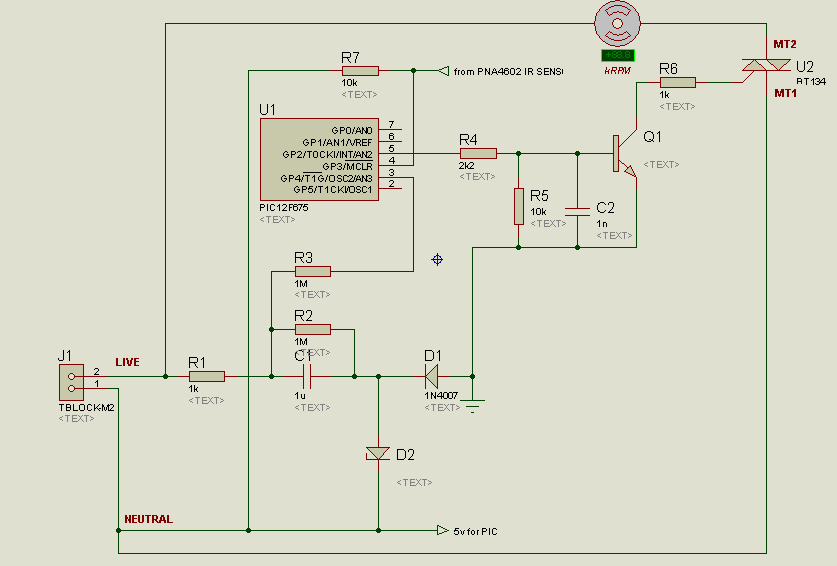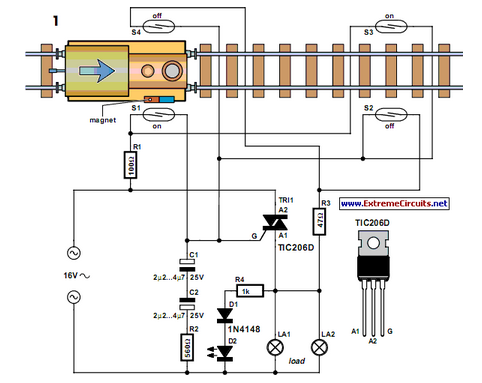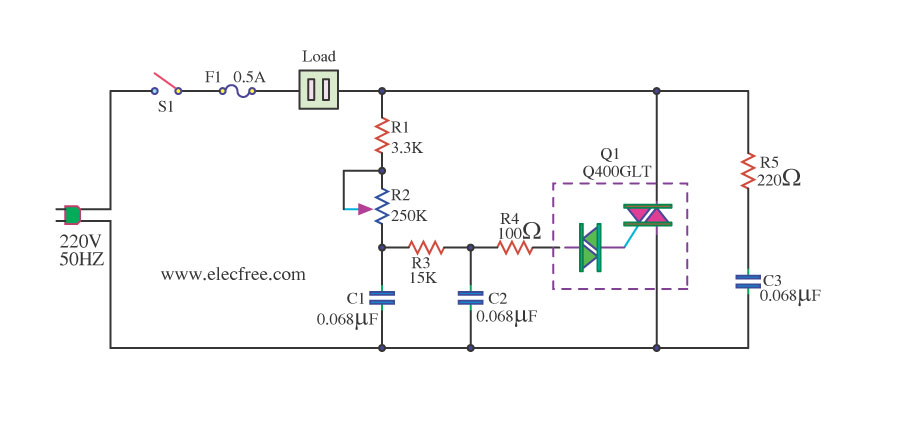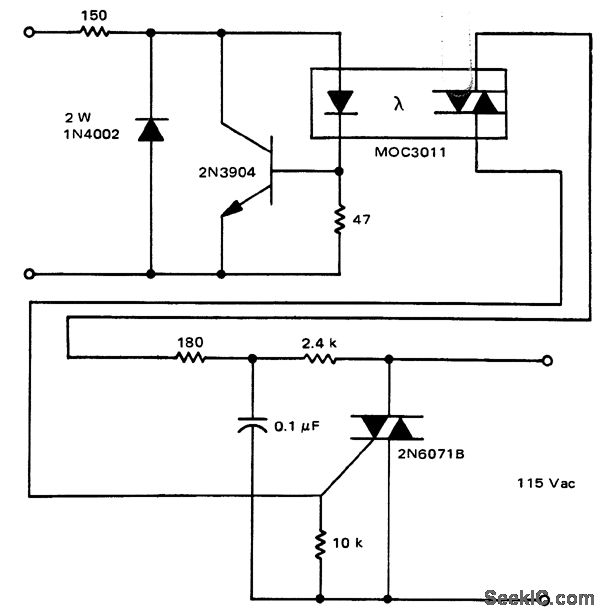
TRIAC
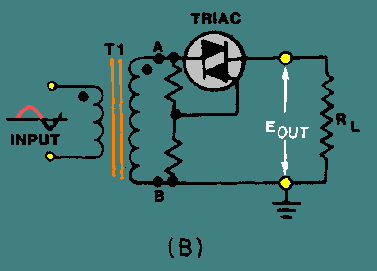
The TRIAC is a three-terminal device that operates similarly to the SCR. Unlike the SCR, which conducts current flow during only one alternation of an AC cycle, the TRIAC allows current to flow during both alternations. The schematic symbols for the SCR and the TRIAC are illustrated in figure 3-23. Both devices feature a gate lead; however, in the case of the TRIAC, the lead on the same side as the gate is designated as "main terminal 1," while the lead opposite the gate is referred to as "main terminal 2." This labeling method is crucial because the TRIAC effectively consists of two SCRs connected back-to-back, sharing a common gate and common terminals. Each terminal functions as the anode of one SCR and the cathode of the other, allowing either terminal to receive an input. The functionality of a TRIAC can be replicated by connecting two SCRs, as depicted in figure 3-24. This configuration results in a three-terminal device that is equivalent to the TRIAC, with the common anode-cathode connections forming main terminals 1 and 2, and the shared gate forming terminal 3. In the circuit shown in view A, the SCR is arranged in a half-wave configuration, where current flows through the load resistor (RL) for one alternation of each input cycle. Diode CR1 is included to ensure a positive trigger voltage. In contrast, in the circuit shown in view B, where the TRIAC replaces the SCR, current flows through the load resistor during both alternations of the input cycle. Since either alternation can trigger the gate of the TRIAC, CR1 is not necessary in this circuit. Consequently, the current flowing through the load will reverse direction for half of each input cycle. To illustrate this difference, a comparison of the waveforms at the input, gate, and output points of the two devices is presented in figure 3-26.
The TRIAC (Triode for Alternating Current) is extensively utilized in AC power control applications due to its ability to conduct current in both directions. This unique capability allows it to control the power delivered to loads such as lamps, motors, and heaters, making it ideal for dimming, speed control, and heating applications. The TRIAC operates by using a gate terminal to trigger conduction, which can happen at any point in the AC cycle, thereby providing versatility in control.
In practical applications, TRIACs are often used in light dimmers, motor speed controllers, and solid-state relays. The device can be triggered by a small current applied to the gate, allowing it to control larger currents through the main terminals without the need for additional components like diodes for triggering, as is required with SCRs. This characteristic simplifies circuit design and enhances reliability.
When implementing a TRIAC in a circuit, it is essential to consider the snubber circuits for protection against voltage transients, which can occur during switching. Additionally, proper heat sinking may be necessary to dissipate heat generated during operation, especially in high-power applications. The choice of TRIAC should be based on the maximum current and voltage ratings required for the specific application, ensuring safe and efficient operation.
The waveforms generated by the TRIAC during operation will typically show a full-cycle AC waveform at the output when triggered correctly, contrasting with the half-cycle output from an SCR. This full-cycle conduction capability allows for more efficient power usage and smoother operation of AC loads. Understanding the differences in operation and applications between TRIACs and SCRs is crucial for engineers designing circuits that require precise control of AC power.The TRIAC is a three-terminal device similar in construction and operation to the SCR. The TRIAC controls and conducts current flow during both alternations of an ac cycle, instead of only one. The schematic symbols for the SCR and the TRIAC are compared in figure 3-23. Both the SCR and the TRIAC have a gate lead. However, in the TRIAC the lead on the same side as the gate is "main terminal 1, " and the lead opposite the gate is "main terminal 2. " This method of lead labeling is necessary because the TRIAC is essentially two SCRs back to back, with a common gate and common terminals.
Each terminal is, in effect, the anode of one SCR and the cathode of another, and either terminal can receive an input. In fact, the functions of a TRIAC can be duplicated by connecting two actual SCRs as shown in figure 3-24.
The result is a three-terminal device identical to the TRIAC. The common anode-cathode connections form main terminals 1 and 2, and the common gate forms terminal 3. In the circuit shown in view A, the SCR is connected in the familiar half-wave arrangement. Current will flow through the load resistor (RL) for one alternation of each input cycle. Diode CR1 is necessary to ensure a positive trigger voltage. In the circuit shown in view B, with the TRIAC inserted in the place of the SCR, current flows through the load resistor during both alternations of the input cycle.
Because either alternation will trigger the gate of the TRIAC, CR1 is not required in the circuit. Current flowing through the load will reverse direction for half of each input cycle. To clarify this difference, a comparison of the waveforms seen at the input, gate, and output points of the two devices is shown in figure 3-26. 🔗 External reference
The TRIAC (Triode for Alternating Current) is extensively utilized in AC power control applications due to its ability to conduct current in both directions. This unique capability allows it to control the power delivered to loads such as lamps, motors, and heaters, making it ideal for dimming, speed control, and heating applications. The TRIAC operates by using a gate terminal to trigger conduction, which can happen at any point in the AC cycle, thereby providing versatility in control.
In practical applications, TRIACs are often used in light dimmers, motor speed controllers, and solid-state relays. The device can be triggered by a small current applied to the gate, allowing it to control larger currents through the main terminals without the need for additional components like diodes for triggering, as is required with SCRs. This characteristic simplifies circuit design and enhances reliability.
When implementing a TRIAC in a circuit, it is essential to consider the snubber circuits for protection against voltage transients, which can occur during switching. Additionally, proper heat sinking may be necessary to dissipate heat generated during operation, especially in high-power applications. The choice of TRIAC should be based on the maximum current and voltage ratings required for the specific application, ensuring safe and efficient operation.
The waveforms generated by the TRIAC during operation will typically show a full-cycle AC waveform at the output when triggered correctly, contrasting with the half-cycle output from an SCR. This full-cycle conduction capability allows for more efficient power usage and smoother operation of AC loads. Understanding the differences in operation and applications between TRIACs and SCRs is crucial for engineers designing circuits that require precise control of AC power.The TRIAC is a three-terminal device similar in construction and operation to the SCR. The TRIAC controls and conducts current flow during both alternations of an ac cycle, instead of only one. The schematic symbols for the SCR and the TRIAC are compared in figure 3-23. Both the SCR and the TRIAC have a gate lead. However, in the TRIAC the lead on the same side as the gate is "main terminal 1, " and the lead opposite the gate is "main terminal 2. " This method of lead labeling is necessary because the TRIAC is essentially two SCRs back to back, with a common gate and common terminals.
Each terminal is, in effect, the anode of one SCR and the cathode of another, and either terminal can receive an input. In fact, the functions of a TRIAC can be duplicated by connecting two actual SCRs as shown in figure 3-24.
The result is a three-terminal device identical to the TRIAC. The common anode-cathode connections form main terminals 1 and 2, and the common gate forms terminal 3. In the circuit shown in view A, the SCR is connected in the familiar half-wave arrangement. Current will flow through the load resistor (RL) for one alternation of each input cycle. Diode CR1 is necessary to ensure a positive trigger voltage. In the circuit shown in view B, with the TRIAC inserted in the place of the SCR, current flows through the load resistor during both alternations of the input cycle.
Because either alternation will trigger the gate of the TRIAC, CR1 is not required in the circuit. Current flowing through the load will reverse direction for half of each input cycle. To clarify this difference, a comparison of the waveforms seen at the input, gate, and output points of the two devices is shown in figure 3-26. 🔗 External reference
